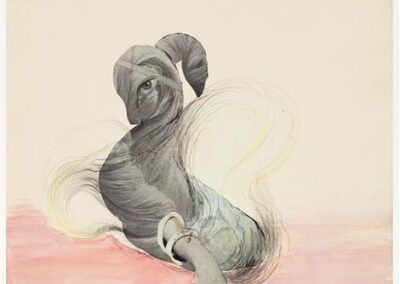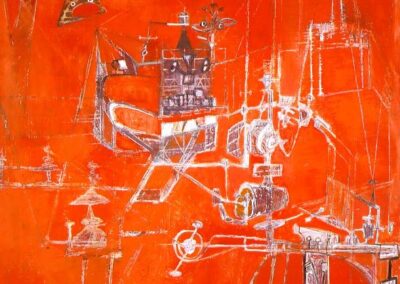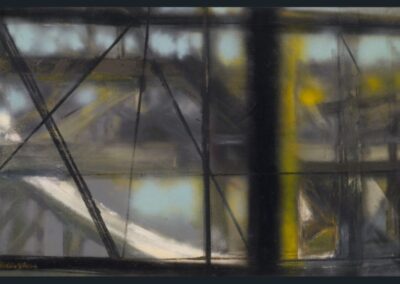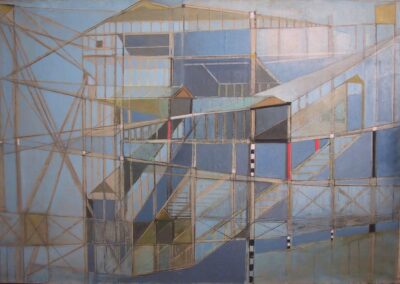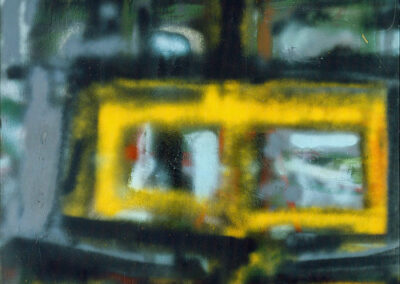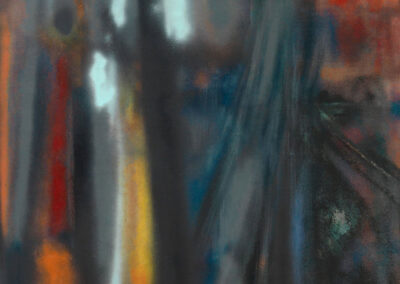The next Artist You Need To Know is Hedda Sterne (1910 – 2011).
Sterne was a Romanian-born American artist who was an active member of the New York School of painters. Her work is often associated with Abstract Expressionism and Surrealism. She was one of the most significant female artists in the post WWII United States painting world, and paved the way for many female artists over her decades-long career.
“I see myself as a well-working lens, a perceiver of something that exists independently of me: don’t look at me, look at what I’ve found.”
Hedda Sterne was born Hedwig Lindenberg in Bucharest, Romania, in 1910 : she was raised to be fluent in French, German, and English. Musical education was more of a family priority, but Sterne was more interested in visual arts and often declared later in life that she’d always known she wanted to be an artist. Her early years were marked by both ‘traditional’ education (respected classical sculptor Frederic Storck) and a formative exposure to Bucharest’s thriving avant-garde cultural scene.
From The Hedda Sterne Foundation : “As a teenager, she attended Constructivist exhibitions and read radical modernist magazines. Central players in the movement became her friends and mentors, including M. H. Maxy and Victor Brauner. By age sixteen, Sterne was working in the atelier of Marcel Janco.” It’s worth noting many of the aforementioned artists were, at the time that Sterne met them or later in their careers, significant trailblazers in terms of DaDa and other groundbreaking art movements of the 20th century. As well, Constructivism – with its connection to Suprematism in the nascent USSR – offered a radical challenge to her more formal education when Sterne was perhaps, as a youth, most open to these ideas.
“The greatest influence in my life when I was young was surrealism, without a doubt.”
Sterne continued her art education outside of Romania after high school : at the Vienna Kunstgewerbeschule (School of Arts and Crafts), in Paris at Académie de la Grande Chaumière, and under the tutelage of painters (and hallmarks of the Cubist movement) Fernand Léger and André Lhote. But she would return to her native city to study philosophy and art history at the University of Bucharest. In the 1920s, Sterne was greatly influenced by the burgeoning surrealist movement and into the 1930s she often travelled to Paris to be immersed in the exhibitions and events of that cultural centre. During this period her mentor and friend Victor Brauner was a champion of her work in the Parisian artistic circles.
Her first solo exhibition – when she was 26 years old – was in Bucharest in 1936 : she would soon be included among the prestigious surrealist groups in Paris. Sterne was included in the 1938 Salon des Surindépendants and the 1939 Salon des Indépendants. This would then lead to her inclusion in group exhibition at Peggy Gunggenheim‘s London (UK) gallery.
But the beginning of WW II would radically alter Sterne’s life – and subsequently her artwork – and precipitated Sterne’s return to Romania. Her marriage had ended amicably in the late 1930s, and her former husband Fritz sought refuge in the United States in 1940. Sterne chose to remain in Bucharest.
From here : “It was a tumultuous time. By the end of the year [1940], Romania had sided with the Axis forces. In January 1941, a political rebellion led to the infamous Bucharest pogrom; Sterne narrowly escaped that night’s roundup and slaughter of Jews in her neighborhood. In the US, Fritz began petitioning to have his family, including his estranged wife, admitted to the country. She spent months collecting all the necessary visas to eventually flee Romania in October 1941.”
Sterne thrived in the United States : “When I came to the United States, I was struck that this country was more surrealistic than anything anybody imagined.”
She quickly established a studio and her neighbour Peggy Guggenheim helped her establish herself as part of the “surrealists in exile.” Sterne also found herself among a community of artists whose work she had admired from afar now among her acquaintances and social circle. These included such giants of 20th Century art as Piet Mondrian, Max Ernst and the writer Antoine de Saint-Exupéry, which whom Sterne was quite close.
Sterne was part of the major exhibition First Papers of Surrealism (1942), exhibited frequently in group exhibitions at Guggenheim’s Art of This Century gallery (including in the major shows 31 Women and The Women). With her first solo exhibition in the United States (1943) at the Wakefield Gallery that was organized by Betty Parsons, Sterne began over twenty years of ongoing exhibitions. She was among the forefront of female painters of her time, and one of the most frequently on view in the American contemporary art scene.
Sterne remained in New York after the end of WW II, eschewing a return to Europe : she would meet and marry Saul Steinberg, and their home became a focal point for their NYC community in terms of culture, ideas and the avant-garde. They would eventually separate but never divorce and remained close until his death in 1999.
She broke ground for many female artists in the U.S. : the ‘controversy’ around her inclusion in the photograph titled The Irascibles speaks to some of the issues in the art world she lived within, around misogyny and reputation over reality. This infamous photograph and its historical ramifications are explored here. Many of those in the image would achieve fame and recognition as the New York School of painters.
“For me, my painting life has been a diary. I’ve functioned almost like a movie camera, moving through the years from immediate nearness to medium distance to far and remote vistas and then back again.”
Sterne passed away at the age of 100 in 2011 : The Hedda Sterne Foundation became the repository for her own collection of artworks by many significant artists, as well as holding her archives and library. From the Foundation : “What she has left behind is an astonishing record of the life of an extraordinary artist. Sterne was a product of the European avant-garde, whose contribution to the rise of American abstraction is yet to be fully comprehended, and whose independence reflects the core role artists play in our society today.”
Hedda Sterne’s artworks can be found in the collections of The Art Institute of Chicago, Carnegie Museum of Art, Pittsburgh, the National Gallery of Art, Washington, D.C., The Metropolitan Museum of Art, Whitney Museum of American Art, the Museum of Modern Art, New York and The Tate Modern, London. She has also had large retrospectives of her work at the Montclair Art Museum (New Jersey, 1977), Queens Museum (New York, 1985), and perhaps the most notable which was Uninterrupted Flux: Hedda Sterne (Krannert Art Museum, University of Illinois at Urbana-Champaign, 2006).
A more detailed listing of exhibitions and collections can be seen here.
“With time, I have learned to lose my identity while drawing and to act simply like a conduit, permitting visions that want to take shape to do so.”
Many more of Hedda Sterne’s artworks – and much more about her life, career and legacy – can be seen at the aforementioned The Hedde Stern Foundation as well as at The Art Story.

